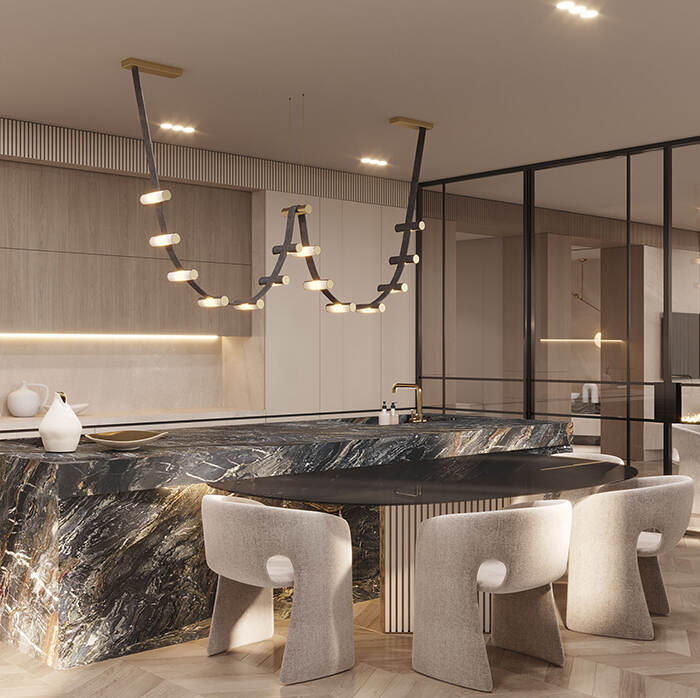 In today’s construction landscape, many homeowners are opting for a Custom Kitchen Cabinet to enhance both the aesthetics and functionality of their spaces, reflecting the ongoing trend of personalized design choices.
In today’s construction landscape, many homeowners are opting for a Custom Kitchen Cabinet to enhance both the aesthetics and functionality of their spaces, reflecting the ongoing trend of personalized design choices.
In today’s construction landscape, the choice of building materials can significantly influence both the aesthetics and functionality of a space. As we explore the dichotomy between natural and engineered materials, it is essential to understand the unique characteristics and potential drawbacks of each. Natural materials, such as wood, stone, and clay, bring an inherent charm and sustainability that many builders and homeowners cherish. On the other hand, engineered materials, designed for enhanced performance and durability, have become increasingly popular in modern construction.
Y&R Furniture, a mature custom kitchen cabinet manufacturer and bathroom vanity factory with over 25 years of experience in the building material industry, has served customers from more than 20 countries. Our expertise allows us to provide a comprehensive solution for different materials tailored to various projects. As we delve into the pros and cons of natural versus engineered building materials, we aim to help you make informed decisions that align with your design goals and practical needs.
Introduction to Building Materials
Building materials are essential components used in the construction of structures, ranging from homes to commercial buildings. These materials can be categorized into natural and engineered types, each offering unique benefits and challenges. Understanding the origins and characteristics of these materials helps builders and designers make informed decisions for their projects.
Natural building materials include wood, stone, and clay, which have been used for centuries due to their availability and aesthetic appeal. They are often appreciated for their eco-friendliness and ability to blend harmoniously with the environment. However, natural materials may come with limitations, such as vulnerability to weathering, pests, and a need for careful sourcing to ensure sustainability.
On the other hand, engineered building materials are designed and manufactured to meet specific performance standards, allowing for enhanced durability and functionality. These materials, such as concrete, steel, and engineered wood products, have revolutionized the construction industry by providing consistent quality and adaptability. While they may lack some of the natural charm, their strength and design flexibility often make them the preferred choice for modern constructions.
Natural Building Materials
Natural building materials are derived from the earth and include substances like wood, stone, clay, and straw. These materials have been used for centuries, often praised for their availability and low environmental impact. Wood, for example, is a renewable resource when sourced from sustainably managed forests, making it a favored choice for both structural and aesthetic elements in construction. The ability to naturally regulate temperature and humidity makes these materials particularly beneficial for creating comfortable living spaces.
One of the significant advantages of natural materials is their ability to blend harmoniously with the environment. They can enhance the aesthetic appeal of a project, providing warmth and character that engineered materials often lack. Natural stone can evoke a sense of permanence and authenticity, while clay provides excellent insulation. Additionally, many natural materials are biodegradable, contributing to a more sustainable approach to building practices, aligning with modern demands for environmental responsibility.
However, there are some downsides to using natural materials. Their performance can be less predictable than engineered alternatives, which are designed for specific functions and environments. Natural wood can be susceptible to pests and weathering, requiring treatment or maintenance over time. Furthermore, the sourcing of these materials can be impacted by supply chain fluctuations, potentially leading to availability issues in certain regions. Despite these challenges, natural building materials continue to be a popular choice for those looking to create eco-friendly and aesthetically pleasing structures.
Engineered Building Materials
Engineered building materials have gained popularity in recent years due to their versatility and performance advantages. These materials are manufactured using a combination of natural resources and advanced technology, creating products that can outperform traditional materials in various aspects. For instance, engineered wood products, such as laminated veneer lumber and engineered beams, offer improved strength and stability, allowing for larger spans and reduced material usage.
One of the significant benefits of engineered materials is their ability to be customized to meet specific project needs. With companies like Y&R Furniture leading the way in custom kitchen cabinets and bathroom vanities, customers can access a wide range of designs and finishes tailored to their requirements. This flexibility not only enhances aesthetic appeal but also optimizes functionality within the space. Moreover, engineered materials often come with enhanced durability and resistance to environmental factors, making them suitable for diverse climates and conditions.
On the downside, the environmental impact of engineered materials can be a concern for some consumers. While they are often designed to reduce waste, the production processes may involve chemicals and adhesives that aren’t as eco-friendly as natural alternatives. Additionally, some engineered products may have a shorter lifespan compared to well-maintained natural materials, leading to questions about long-term sustainability. However, as technology progresses, many manufacturers are working towards developing greener alternatives that aim to mitigate these issues.
Comparative Advantages and Disadvantages
Natural building materials, such as wood, stone, and clay, offer numerous benefits that are often prized in construction. They are typically more sustainable, as they are sourced from renewable resources and can have a lower carbon footprint. The aesthetic appeal of natural materials also contributes to their popularity, providing warmth and a unique character to spaces. Additionally, they can be more durable, resisting wear and tear over time when maintained properly.
On the other hand, engineered building materials like composite wood and manufactured stone have their own set of advantages. They often boast superior strength and uniformity, allowing for precise construction and manipulation. Engineered materials can also be designed to meet specific performance criteria, such as increased moisture resistance or enhanced insulation properties. This versatility makes them appealing for projects requiring customized solutions without sacrificing quality.
However, there are drawbacks to consider for both types of materials. Natural materials can be more susceptible to environmental factors such as moisture and pests, potentially leading to higher long-term maintenance costs. Conversely, engineered materials may have a higher environmental impact during production and might not be as biodegradable as their natural counterparts. Understanding these advantages and disadvantages helps builders, like Y&R Furniture, provide tailored solutions that meet the diverse needs of their clients.
